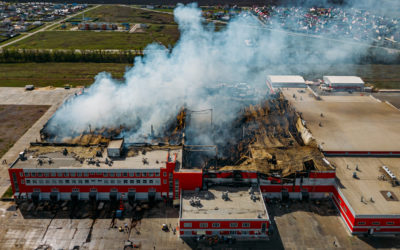Cobra used on a propagating lithium-ion battery module.
Lithium-ion batteries vary in size and are found in a wide range of applications, from electric bikes and mobile phones to electric vehicles and energy storage systems. These batteries are often in a battery pack, a composition of multiple battery modules, each containing several battery cells. For example, an electric vehicle’s traction battery is made up of several interconnected battery modules.
Propagating Lithium-Ion Battery
When a lithium-ion battery is damaged, its cells can enter thermal runaway, a condition where the cell’s temperature rises uncontrollably, and the built-in safety mechanisms fail to stop it. This can happen due to mechanical damage, overheating (such as from overcharging or thermal exposure), or other causes like internal electrical faults.
If one cell undergoes thermal runaway, it can generate enough heat to trigger a similar reaction in adjacent cells, leading to a propagation of thermal runaway.

How can we stop propagation in lithium-ion battery?
The most effective way to stop this process is by cooling the affected cells internally, which can be achieved by establishing an internal flow of water. Integrating Cold Cut Cobra into a fire suppression strategy for safer lithium-ion battery handling offers a way to do this.

Method
Use thermal imaging camera (TIC) to confirm propagation and find a suitable point of attack. If it is a fire in a bigger context involving a battery pack, an additional active water source should be present, whose primary task is to knock down flames that are in direct danger to the Cobra Operator.
It is important that the Cobra Operator is patient and remains at the point of attack, to create a flow of cooling water that finds its way through the battery pack.
Throughout the operation, the progress is monitored by a TIC. The aim of the Cobra attack is to cool the battery module and its internal battery cells, ensuring that the temperature drops and remains stably low. Only when a stable temperature has been reached can the propagation be considered stopped and the Cobra attack finished. The operation can be considered completed when the fire is extinguished, and the propagation stopped.
Cobra allows quick and easy access and is possible to reposition if results are not achieved. In addition, Cobra uses only 60 litres of water per minute which saves the environment unnecessary amounts of runoff water. Using a traditional branch will not only lead to large amounts of water usage, but it is also practically impossible to stop the propagation until the entire battery pack is burnt out.
As in most operations, communication is vital. The Cobra Operator may be unable to see what effect Cobra is having, which makes good communication between the crew, Cobra Operator and Incident Commander essential to get the Cobra lance into the best position. Knowledge of battery geometry is important so that Cobra can be applied to maximum effect.

Cobra Benefits
Quick and easy access.
The equipment is light in weight and easy to handle, which enables rapid deployment and easy to move the lance where needed. The training programme that underpins Cobra gives fire crews the ability and confidence to deploy Cobra very quickly on arrival. In addition, Cobra can be used from any angle and to optimize effort the attachable lance extender can be used, a great way to access a battery module that is placed in a tricky position.
Limits water damage.
Using traditional firefighting methods when fighting propagation in lithium-ion batteries uses a considerable amount of water, 450 litres (119 gal) per minute or more, and can result in significant water damage to the surroundings. Cobra uses 60 litres (16 gal) of water per minute, considerably less than traditional firefighting methods.
Limits water use.
As Cobra only uses 60 litres (16 gal) of water per minute, an 1800 litre (475 gal) water tank will last 30 minutes if Cobra is used continuously.
Multi-functional tool.
Cobra can be used in several possible scenarios; it is not a specialist tool intended only for fires in lithium-ion batteries.
Benefits of Cobra use
- Can be used from any angle.
- Limits water damage.
- Limits water use.
- More than a single-solution tool.
Source: Zhang, L., Jin, K., Sun, J., & Wang, Q. (2022). A Review of Fire-Extinguishing Agents and Fire Suppression Strategies for Lithium-Ion Batteries Fire. Fire Technology.


